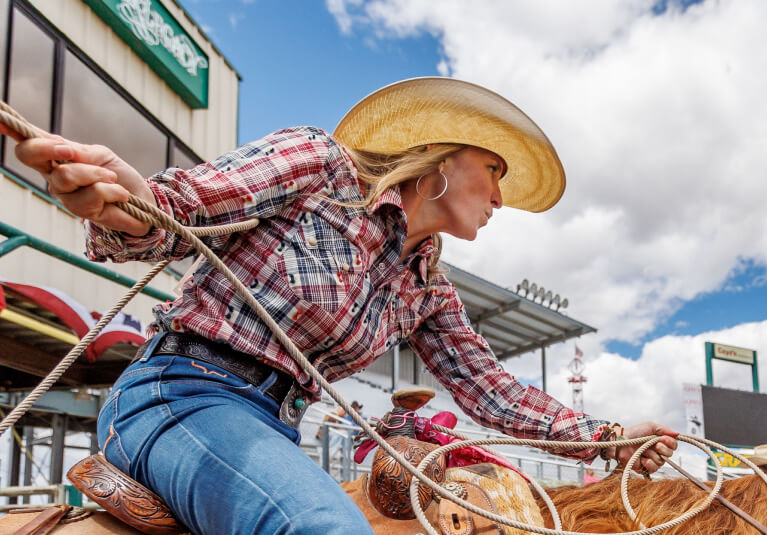RENO RODEO 101
Hey Reno Rodeo fans! It’s time for some Rodeo 101. Whether you’re new to the rodeo or want to freshen up on the lingo, this guide has everything you need to know for each event.
GRAND ENTRY
The Grand Entry marks the opening to each performance at the Reno Rodeo. Fans know the excitement is about to begin when when they see the parade of rodeo officials, horses and flags.

STEER WRESTLING
It is all about speed and strength when it comes to steer wrestling.
The steer wrestler, who is called the bulldogger, starts on horseback behind a barrier. The steer is given a head start. Once the steer reaches the advantage point, the barrier is released and the bulldogger takes off after the steer. If the bulldogger leaves too soon and breaks the barrier, he receives a 10-second penalty.
The steer wrestler is assisted by a hazer, another cowboy on horseback tasked with keeping the steer running in a straight line.
When the bulldogger’s horse pulls even with the steer, he eases down the right side of the horse and reaches for the steer’s horns. After grasping the horns, he digs his heels into the dirt. As the steer slows, the cowboy turns the animal, lifts up on its right horn and pushes down with his left hand.
After the catch, the steer wrestler must either bring the steer to a stop or change the direction of the animal’s body before the throw or is disqualified. The clock stops when the steer is on his side with all four legs pointing in the same direction.
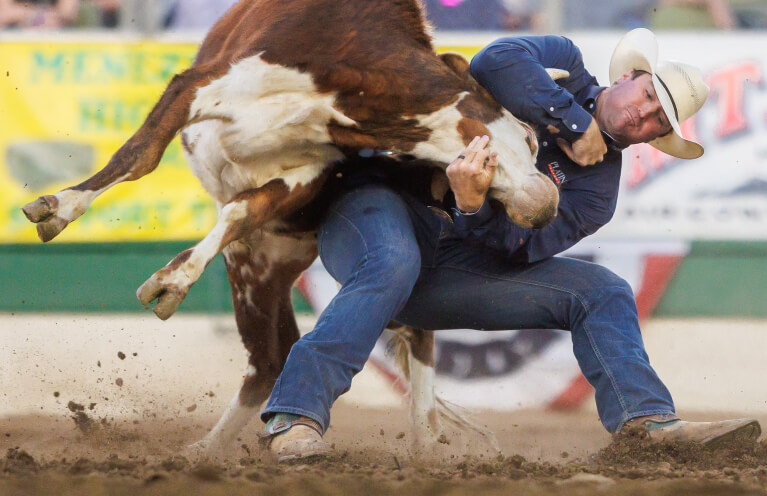
TIE-DOWN ROPING
The origin of tie-down roping goes back to the days of the Old West. When ranch hands needed to gather cattle for medical attention or branding, they would take pride in who could rope and tie calves the quickest.
Today, it has become a favorite at the Reno Rodeo. This timed event requires the horse and its rider to work together to catch and tie down the runaway calf, who is given a head start. The roper and horse start behind a barrier in the roping box. When the barrier is released, the roper takes off and throws the rope around the calf’s neck. The horse comes to a stop so the roper can dismount, flip over the calf and tie any three of the calf’s legs.
When the roper completes his tie, he throws his hands in the air to signal to the judge to stop the clock. He then remounts his house and allows his rope to become slack. In order for the roper’s time to be recorded, the calf must stay tied for an official three seconds. If the calf comes untied before then, the team receives a no-time. A ten-second penalty is added if the horse and the cowboy break the barrier at the start.
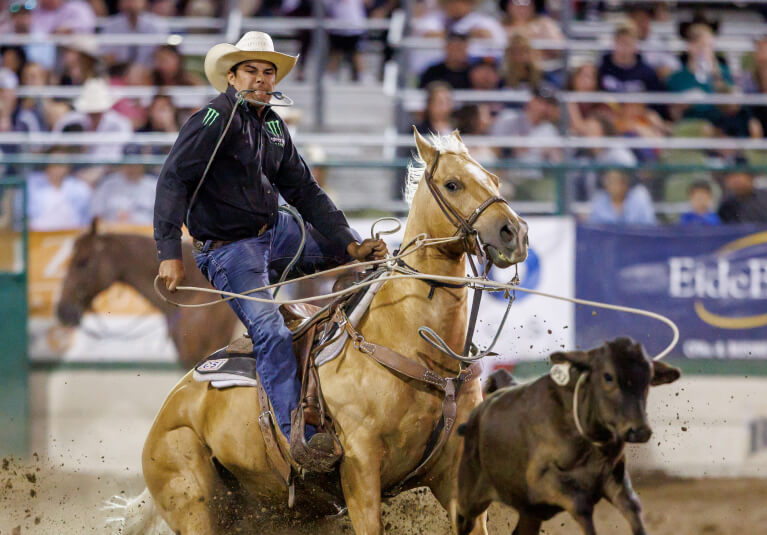
BARREL RACING
A fan favorite, barrel racing is a women-only rodeo event that is known for quick turns, high speeds and edge-of-your-seat excitement where the winner is often determined by thousandths of a second!
Three barrels are placed in a triangular pattern in the arena and the cowgirl must ride around each one in a clover-leaf pattern without knocking any down. If a rider knocks over a barrel, she receives a five-second penalty. The rider with the fastest time wins!
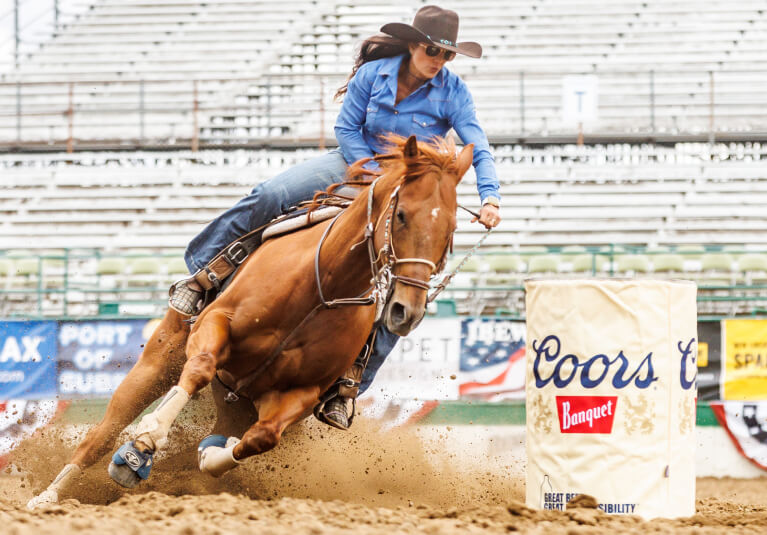
BULL RIDING
One cowboy, a 2,000-pound bull and an eight-second ride. That all adds up to Bull Riding.
This exciting event tests the cowboy’s strength and ability unlike any other. The rider must hold on to a flat, braided rope that is wrapped around the bull’s torso. Once the bull is released from the chute, the rider must hold on with his other hand in the air for eight seconds.
The event is judged on a 100-point scale. Judges watch for proper body position and other factors, including the use of the free arm and spurring action. Although not required, spurring will add points to a rider’s score. A bull rider will be disqualified for touching the animal, himself or the equipment with his free hand.
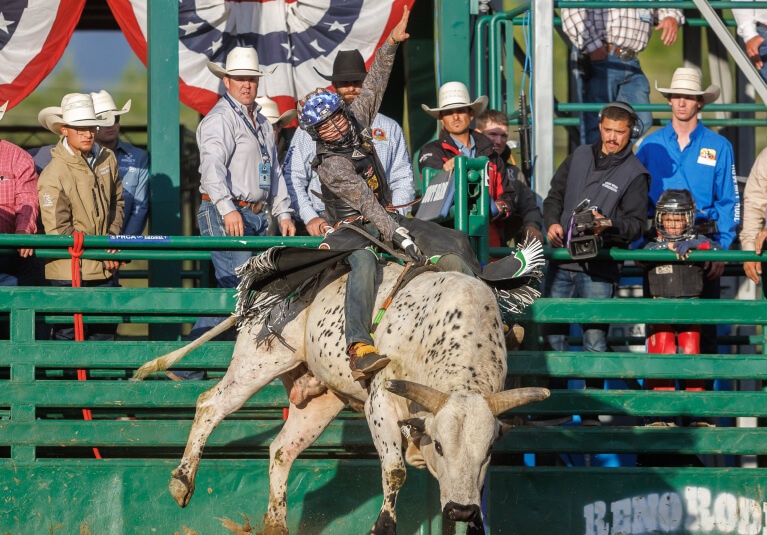
BAREBACK RIDING
Hang on there, cowboy! Bareback riding is one of the most physically demanding events, making it exciting to watch. It tests the cowboy’s strength and technique as the rider tries to hang on for the eight-second ride.
A bareback rider begins his ride with his feet placed above the break of the horse’s shoulder. If the cowboy’s feet are not in the correct position when the horse hits the ground on its first jump out of the chute, the cowboy has failed to “mark out” the horse properly and is disqualified.
Throughout the eight-second ride, the cowboy must keep one hand on the rigging—a handhold made of leather and rawhide placed behind the horse’s front legs—while keeping the other hand in the air.
The rider is judged on his control and on his spurring technique. The score also is based on the rider’s “exposure” to the horse’s strength, and the horse’s performance accounts for half the total score. A rider is disqualified if he touches his equipment, himself or the horse with his free hand.

TEAM ROPING
In this timed event, it all comes down to teamwork and trust. Team roping is the Reno Rodeo’s only true team event. The two ropers—the header and the heeler—must work together to catch a steer.
The header is to the left of the steer and the heeler is to the right of the steer. The header leaves the roping box on horseback in pursuit of the steer. He must first rope the setter around both horns. If the header misses, the team receives a no-score.
After the header makes his catch, the heeler moves in and ropes the steer’s hind legs. Both legs must be caught with the rope; if the heeler only gets one leg, the team receives a five-second penalty. The team is also penalized if the header leaves the box too soon and breaks the barrier. The run is completed when the steer is secured, and the team’s horses are facing each other on opposite sides of the steer.
The Grand Entry marks the opening to each performance at the Reno Rodeo. Fans know the excitement is about to begin when when they see the parade of rodeo officials, horses and flags.
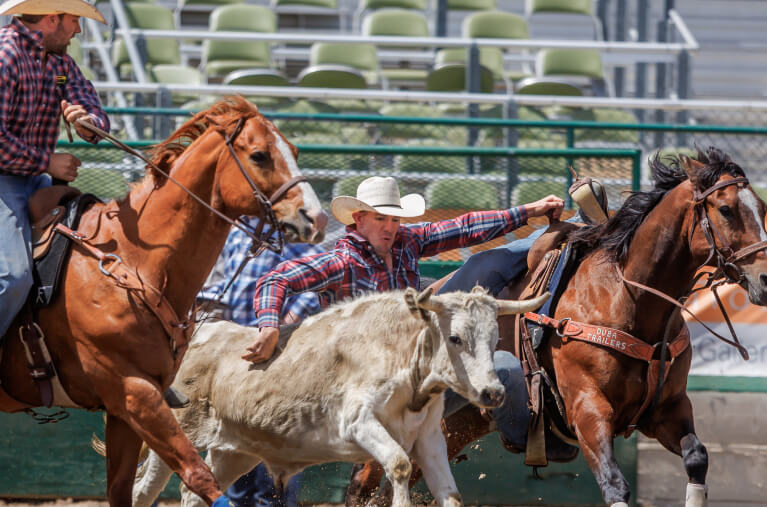
SADDLE BRONC RIDING
Hold on to your horses! Similar to Tie-Down Roping, Saddle Bronc Riding also traces its roots to the Old West when cowboys would throw saddles on wild horses to train them. Saddle Bronc Riding is considered a classic rodeo event.
Once the chute gate opens, it’s time to hold on! The cowboy needs to maintain control of the horse as he sits securely in the saddle and holds on to a thickly-braided rein that is attached to the horse’s halter. The rider must keep his free hand in the air and his feet in the stirrups. If the cowboy’s feet slip from the stirrups or he touches the rein or the horse, he is disqualified.
The cowboy is scored on his control throughout the ride, the length of his spurring stock and how hard the horse bucks. The heels of the rider’s front feet must also remain above the horse’s shoulders until the first jump.
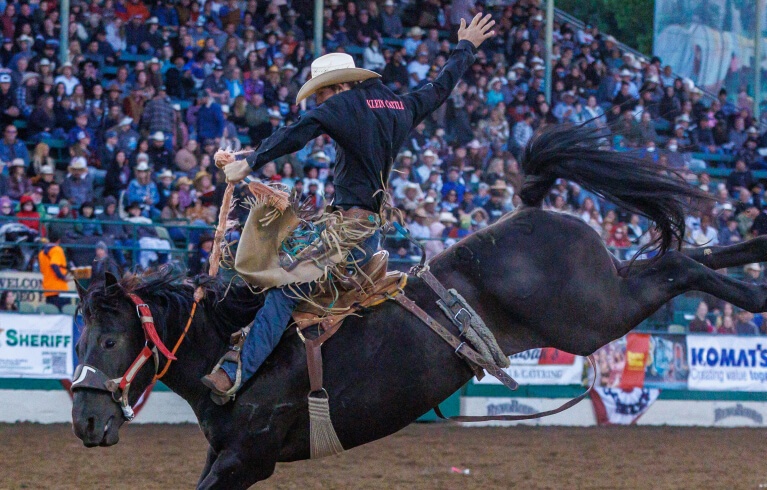
BREAKAWAY ROPING
A newer event for the Reno Rodeo, Breakaway Roping is a variation of calf roping. An all-women event, the cowgirl starts on horseback in the chute to give the calf a head start. Once the calf is released, the cowgirl races after it to rope it with a “bell collar catch.” When the rope is pulled tight, it “breaks away” from the saddle where it is tied with a piece of string. When the string breaks, the calf is released and the clock stops.
This event is lightning-fast; most breakaway runs only last between two and four seconds. The cowgirl must wait for the calf to get a proper head start; otherwise, the competitor will receive a ten-second penalty. Also, only the calf can break the rope away from the saddle. If the roper releases the rope, it results in a no-time.
